Cognitive Training & Enrichment with an African Crested Porcupine Enhances Zoo Visitor Experience
by Joan M Sinnott, PhD
This article is a memorial to African Crested Porcupine Joey (2012-2024), who spent an incredibly fruitful 10 years as a Utica Zoo Animal Ambassador and showed all who encountered her how smart zoo animals are!

Joan M Sinnott (JMS) is a Comparative Psychologist Emerita who retired from the University of South Alabama in 2012 and is now a docent in the Utica Zoo Education Department.
Her work combines animal cognition training and animal enrichment, with the ultimate goal of enhancing Utica Zoo visitor experience.
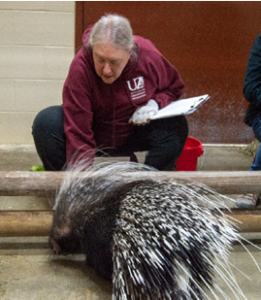
Many AZA-accredited zoos are using extremely sophisticated forms of cognitive enrichment for their animals, using procedures that were first developed in academia by comparative psychologists (1). For example, Chicago Lincoln Park Zoo has Japanese macaques using computer symbols on a touch-screen (2), and Zoo Atlanta has a similar “learning tree” program for orangutans (3). Of course, we all know that primates are smart, but what about other exotic animals that have never been particularly appreciated for their cognitive capacities? For example, how about African Crested Porcupines?
To this end, I started developing a form of cognitive training and enrichment for Joey, a female African Crested porcupine (Hystricidae, Hystrix cristata). Joey was born at the zoo in 2012, and was chosen at birth to be an ambassador animal in our education department, in order to add more biological diversity to our collection. This upbringing gave her a good start in her intellectual development, since from the age of one week, she was raised with lots of love, attention, and stimulation from zookeepers.
To keep Joey in close contact with humans, I decided to introduce her to a very socially-oriented training/enrichment program that would involve her interacting with people, since this area of animal welfare is the focus of considerable interest in zoos today (4). The ultimate goal would be to introduce Joey to zoo visitors as she engages in these complex activities.
In 2014, I started training Joey (at age 2) on a classic reversal procedure, which is one of the earliest “intelligence tests” used in the field of Comparative Psychology (5). Here the animal is trained to perform on a 2-choice procedure, typically using 2 directional responses of GO-LEFT vs. GO-RIGHT. The goal is to determine if s/he can figure out when to reverse responses from LEFT to RIGHT (or vice versa) to earn food treats.
- (1) Sinnott JM (1987). “Modes of Perceiving and Processing Information in Birdsong”. Journal of Comparative Psychology 101, 4, 355-366.
- (2) Chicago Lincoln Park Zoo, 1918 Winter Newsletter.
- (3) Zoo Atlanta Facebook Page [cited in Connect, June 2019, p. 10].
- (4) Mellor DJ, Beausoleil, NJ, Littlewood KE, McClean AN, McGreevy PD, Jones B & Wilkins C. “The 2020 Five Domains Model: Including Human-Animal Interactions in Assessments of Animal Welfare”, Animals 2020, 10, 1870. [cited in Connect, January 2021, p. 17].
- (5) Warren J & Warren H (1962), “Reversal Learning by Horse and Raccoon”, Journal of Genetic Psychology 100, 215-220.
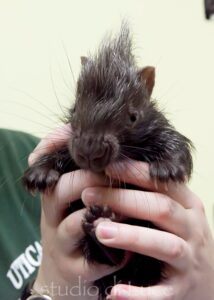
Baby Joey was raised with lots of love, attention, and stimulation from zoo staff.
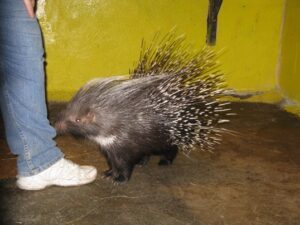
As a youngster, Joey got acquainted with lots of different zookeepers.
NOW follow along as Joey pursues her career towards higher learning!
1. JOEY’S CLASSIC REVERSAL TRAINING
2. JOEY’S INTRODUCTION TO A ZOO VISITOR
3. JOEY ADVANCES TO HIGHER FORMS OF REVERSAL LEARNING
1. Joey’s Classic Reversal Training
To start Joey off on her academic career, I first construct a “classroom” for her, consisting of a 7-ft long wooden fence and two tree stumps as markers to guide her to the center of the fence, which separates the human trainer area from Joey’s test area.
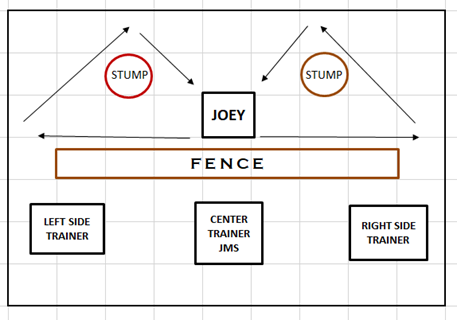
Diagram of Joey’s classroom showing the fence and stump markers.
Joey = Joey starts a trial here.
Three trainers (Left, Center, Right) sit across the fence from Joey.
The arrows show Joey’s footwork as she learns the reversal procedure.
Joey Learns to Center
When I first set up the fence, Joey does not come near it, not even to get her normal afternoon food from her normal feeding bowl. But after a few days, she is eagerly taking small pieces of apple from my feeder under the center fence position.

Joey comes to the center of the fence to receive a piece of apple from JMS.
Joey Learns to Go-Left and Go-Right
Next, I bring in Erin, Joey’s main caretaker, as a side trainer. Each day, Erin alternates sitting on the left or right side of the fence. I center Joey and start repeating “ERIN, ERIN, ERIN”, while Erin shows Joey a piece of sweet potato and says “I’m Erin”. Joey sees Erin with the food, and goes to her immediately. She starts working for 20 trials each day, first taking the apple from me in the center, then going to Erin on either the left or right side of the fence to get her treat, then circling around the stump to return to the center position for the next trial.
Joey Learns to Reverse from Left to Right, or Vice-Versa
After a couple of days, I bring in Beth, another zookeeper, as a second side trainer who sits on the opposite side of the fence from Erin. After Joey completes 10 trials with Erin, I now switch to repeating “BETH, BETH, BETH” for the final ten trials, while Beth gives Joey her reward and says “I’m Beth”. Joey easily learns to reverse her responding after 10 trials and now go to Beth.
Turning Joey’s Response Into Operants
Up until now Joey’s responses are pretty reflexive, since she simply goes to the trainer who has the food. But after learning this footwork, Joey is now ready for actual operant conditioning. After centering and hearing a trainer’s name, Joey must now go all the way to the end of the fence to that specific trainer, at which point I say “GOOD” and only then does Joey get her treat from that trainer. If Joey goes to the wrong trainer, I say “NO” and Joey gets no treat. A correction procedure is in effect, so that the missed trial is repeated until Joey gets it correct. I also start bringing in new zoo staff member as trainers to sit opposite Erin, so that Joey can meet some new people, and listen to some new names (KATHLEEN / MARY / JAN / DANIEE / NIKKI).
Collecting Data
After a couple of weeks of training Joey in the reversal procedure, it’s now time to collect some data! We test Joey for 20 trials in each session, starting her off each day with 10 trials on either the left or right side, and then reversing her to the opposite side on trial 11.
The important question is:
Will Joey learn to reverse correctly on trial 11, when the name of the side trainer changes?

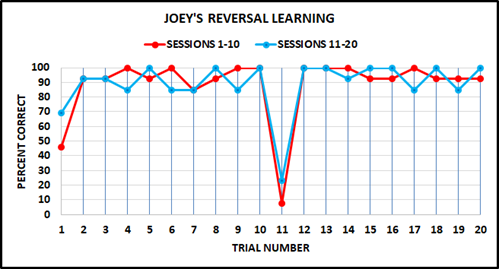
Shown above are Joey’s data for 20 sessions of reversal testing. Chance performance on a 2-choice test is 50% correct, and 75% correct is considered evidence of learning. Joey performs well on all the trials EXCEPT for #1 and #11. On trial 1, Joey’s responses are below 75% correct, indicating that she isn’t paying attention to the name “ERIN”, and is simply guessing where to go. But then she performs at >80% correct on trials 2-10. On trial 11, the reversal occurs, but she isn’t paying attention to the name change in the trainer, and actually goes the wrong way. But then she performs at >80% correct on trials 12-20, until the end of the session.
This is the classic way animals solve the reversal problem:
They engage in a WIN-STAY/LOSE-SHIFT strategy.
In other words, Joey is thinking:
“First I guess until I get it right,
then I stick with this response until I make a mistake,
whereupon I change my response to the opposite side,
and stick with this one until my session ends!”.
So Joey has a great working short-term memory, enabling her to remember which direction she went to on any given trial, and then direct her future responses accordingly to earn her reward. Joey also seems to give serious thought to performing her task, because sometimes she starts going (incorrectly) to one trainer, then stops about half-way there, hesitates, then turns around and goes (correctly!) to the other trainer! It’s fascinating to watch this behavior, and you can almost feel her little brain waves vibrating as she endeavors to select the correct side trainer for that particular trial.
Equally important, Joey appears to enjoy this form of cognitive and social enrichment with humans. She gets very excited when we enter her room to begin testing, shaking her quills and turning circles around the stumps, as she patiently waits for us to set up her apparatus. To summarize, Joey’s behavior during our human-animal interactive testing appears to be for her a positive welfare impact*.
*see Mellor DJ, Beausoleil, NJ, Littlewood KE, McClean AN, McGreevy PD, Jones B & Wilkins C. “The 2020 Five Domains Model: Including Human-Animal Interactions in Assessments of Animal Welfare”, Animals 2020, 10, 1870, cited in Connect, Jan 2021, p. 17.
2. Joey’s Introduction to a Zoo Visitor
Joey’s performance on the reversal procedure, using several different zoo staff members as side trainers, showed us that she was not intimidated by encountering new people as she worked. So now it’s time to bring in a zoo visitor as a trainer! Below we show Joey in action with JMS as the Center Trainer, zookeeper Erin as the left-side trainer, and zoo visitor Leah as the right-side trainer.
1. Joey makes a LEFT response, going toward zookeeper Erin (in blue). Erin has a bit of sweet potato ready, but she will not feed Joey until Joey reaches the end of the fence and JMS (in white) says “GOOD”.
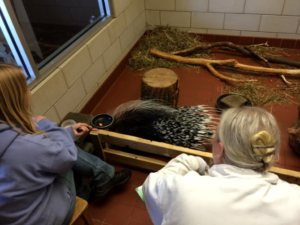
2. Erin feeds Joey on the LEFT side of the fence. JMS records a correct response for Joey.
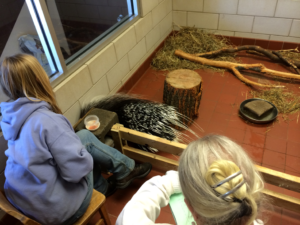
3. After getting her treat, Joey circles the left stump to return to an unbiased center position to begin the next trial.

4. WHOOPS! It’s trial 11 and Joey makes a mistake! She goes LEFT, but this time she is supposed to go RIGHT, so Erin did not feed her. JMS says “NO” and records an incorrect response for Joey, who circles the stump to return to center.

5. Joey makes a correct RIGHT response, this time to Leah, a zoo visitor (in red).
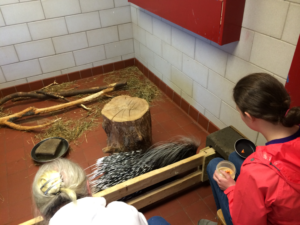
6. Leah leans over to feed Joey.

A GRAND EXPERIENCE FOR A UTICA ZOO VISITOR!
3. Joey Advances to High Forms of Reversal Training
Although Joey mastered the classic reversal procedure, note that she did not listen to the trainer names on Trials 1 & 11 to tell her where to go. So we changed the procedure a bit to make it easier for JOEY to learn to reverse by always starting her on the left side on Trial 1 with an anchor trainer (Mary Hall, UZ Education Director) and anchor name “MARY”, and always reversing her to the right side on Trial 11 with a variable trainer and name.
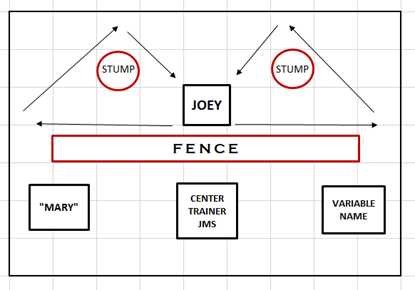
Joey’s new procedure requires her to always start on the left with the name “MARY” and reverse to the right on Trial 11 when she hears a different, variable name.

Joey’s performance on all trials (including #1 and #11) reached >= 80% correct after 30 test sessions.
Our next test was designed to see how many reversals Joey could handle within her 20-trial session. Was she really listening to the name change on Trial 11, or was she somehow “counting” the number of trials until reversing, or maybe even timing herself in some mysterious way before reversing?
To answer this question, we started increasing the number of reversals per test session, from 1 (trial #11) to 2 (trials #8,15) to 3 (trials #6,11,16) to 4 (trials #5,9,13,17), to 6 (trials #4,7,10,13,16,19), and finally to a quasi-random presentation of reversals, varying anywhere from 2-5 reversals within a test session.

Results show that Joey maintains her 90% correct performance as the number of reversals increases from 1 per session to RANDOM. She is actively listening to the trainer names as opposed to counting trials!
An additional data analysis was performed to see how Joey reacted to variable right-side trainers. Does she perform better with trainers she encounters more frequently, compared to those she encounters for only a single session?
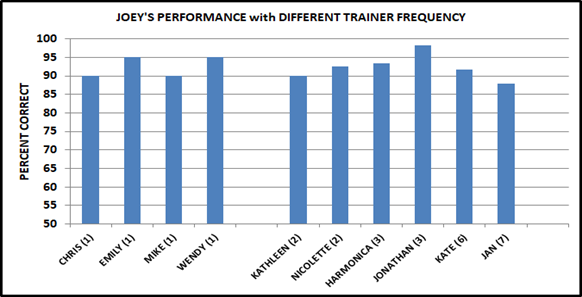
Joey’s 90% correct reversal performance with variable right-side trainers.
The number of sessions tested with each person is listed with each name.
Note that four people were only tested ONCE, and Joey did GREAT with them!
It’s clear that JOEY performs really well on meeting new people!
We will all miss Joey (2012-2024)
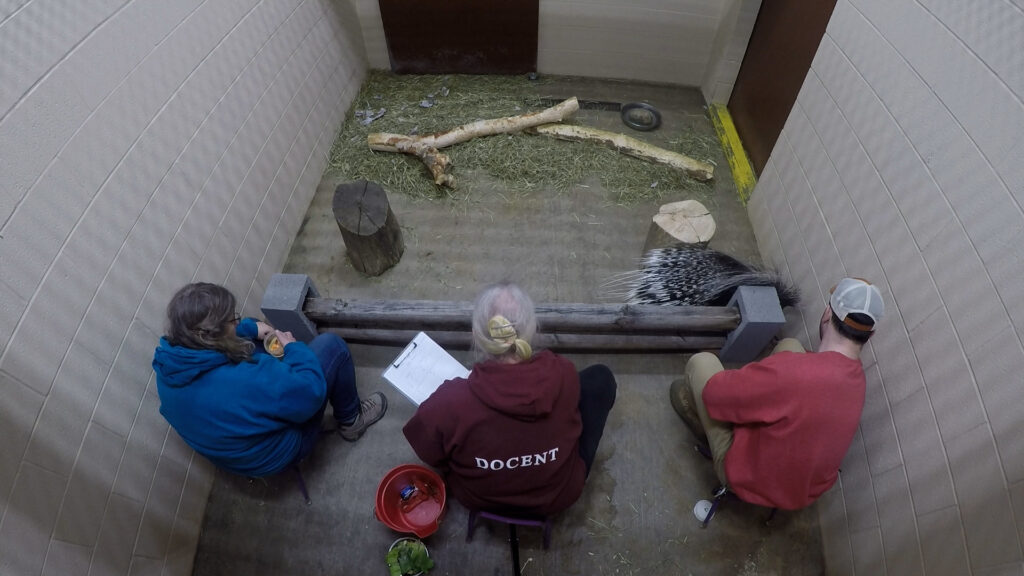
Joey works with anchor trainer “MARY” (left), JMS (center), and variable trainer “MARK” (right).

FOREGROUND: Joey works with variable trainer “KAYLA” (left), JMS (center), and anchor trainer “MARY” (right).

Joey works with variable trainer “ANDRIA”.
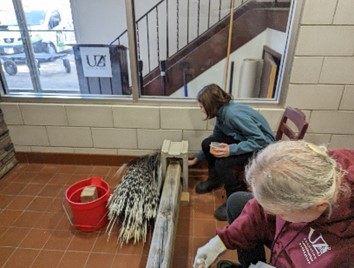
Joey works with variable trainer “JOSIE” (Mary’s granddaughter).
STAY TUNED TO THE UTICA ZOO WEBSITE FOR OUR LATEST DEVELOPMENTS IN:
ANIMAL COGNITION TRAINING,
ANIMAL ENRICHMENT,
AND ZOO VISITOR EXPERIENCE!
